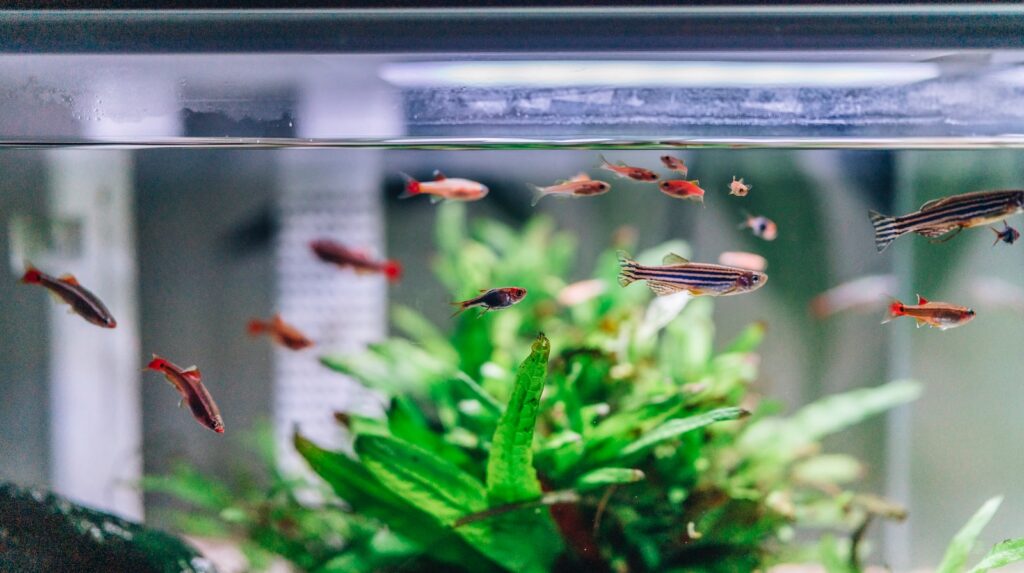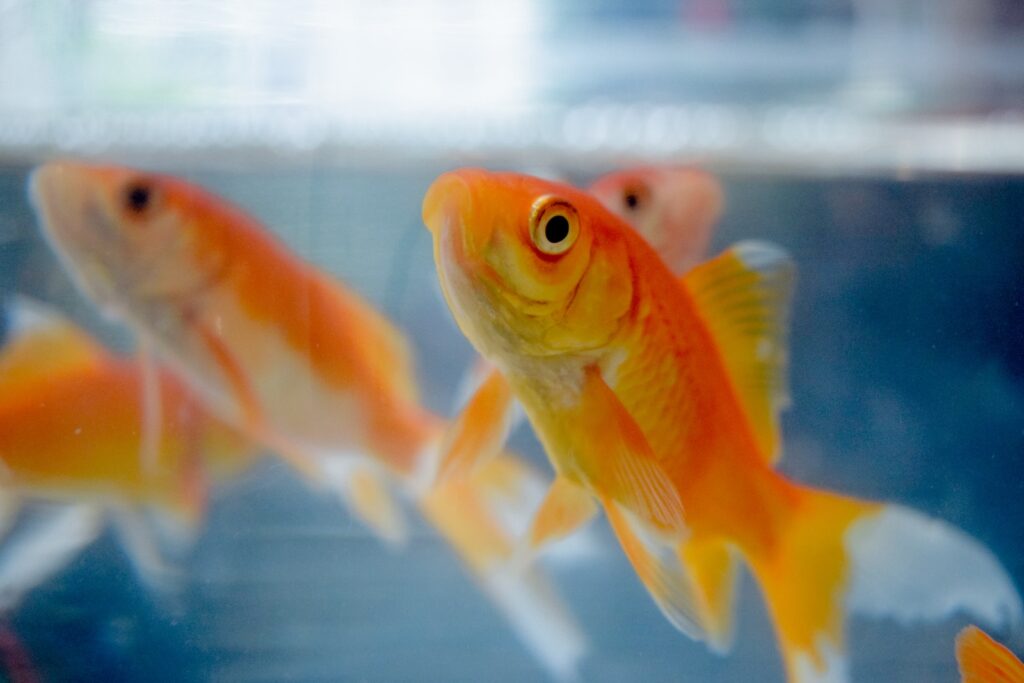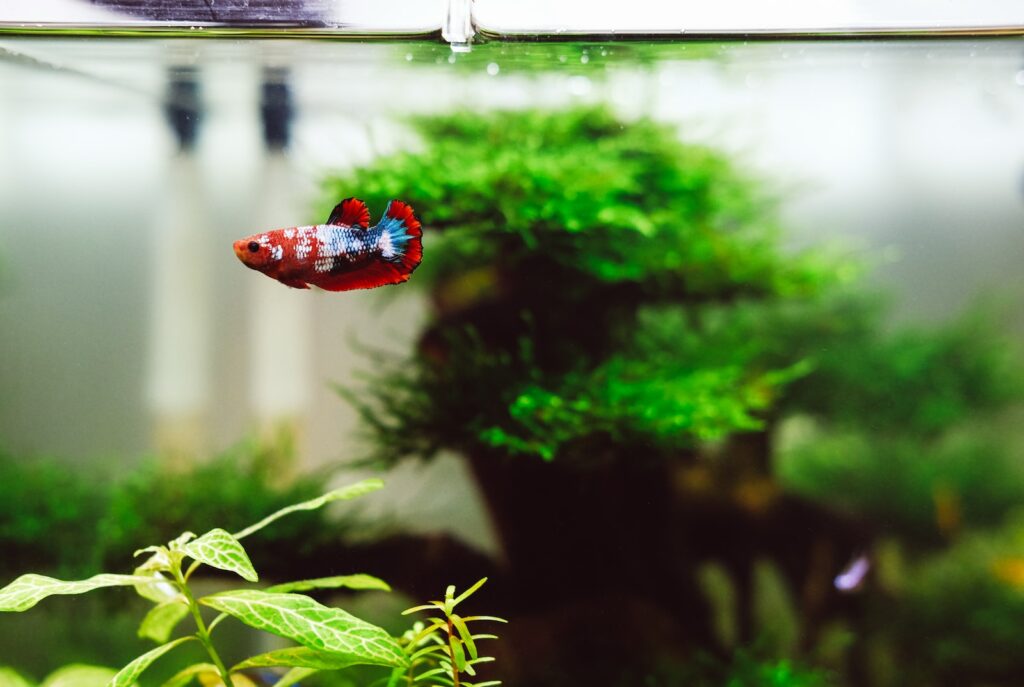Fish tales, anyone? Nope, we’re diving straight into the heart of reef aquariums, a vibrant representation of the ocean’s splendor, right in the comfort of your home.
1. Understanding What a Reef Aquarium Is
Ever been fascinated by the mysterious allure of the deep blue sea? A reef aquarium brings a snapshot of that world to your living room.
Basics of a Reef Tank
At its core, a reef tank is an underwater wonderland. It’s a living canvas, capturing the vibrant marine ecosystem found in the world’s natural coral reefs. This closed system houses a variety of marine organisms, from fish to invertebrates, all coexisting in a delicate balance.
Why Reef Over Regular?
While Goldie the goldfish holds a special place in many hearts, reef tanks offer a vivid palette of marine life. They pulsate with a dazzling array of colors and species. From the shimmery dance of fish to the tranquil beauty of corals, it’s a slice of oceanic magic.
The Components
A successful reef aquarium goes beyond just water and marine life. It’s a symphony of components working in tandem. There’s the intricate dance of lighting, the rhythm of water circulation, and the careful choice of substrates. Each piece, no matter how seemingly trivial, plays a pivotal role in creating the right environment.
Significance of Coral
Corals are the heartbeats of a reef aquarium. Far from being mere underwater decor, they serve as the primary architecture of the marine world. These fascinating organisms do more than just add aesthetic value. They offer shelter, act as a food source, and play a central role in marine ecology, acting as a habitat for countless marine species.
2. Setting Up Your First Reef Aquarium
Excitement is in the air as you gear up to set up your very first reef aquarium. But where to start? Let’s guide you through it.
Choosing the Right Tank
Size does matter, especially in the world of reef tanks. Larger tanks, although demanding a higher initial investment, offer a buffer against rapid changes in water parameters. This extra volume provides a safety net, ensuring the environment remains stable for its marine inhabitants.
Lighting Matters
Light is life for many marine organisms, especially corals. They rely on it for photosynthesis, drawing energy from light through their symbiotic relationship with zooxanthellae. But it’s not about flooding the tank with luminosity. The right spectrum, intensity, and duration are crucial. And remember, it’s not a disco; excessive light can harm corals!
Water Chemistry
Creating the perfect marine cocktail requires a keen eye on water chemistry. Tracking pH levels, salinity, and other essential parameters is pivotal. It’s where your high school chemistry knowledge kicks in. Note down readings, monitor changes, and yes, maintain that diary. It’s all worth it for a thriving marine habitat!
Filtration Systems
Think of the filtration system as the kidneys of your tank. While clear water is pleasing to the eye, it’s the invisible toxins that we need to worry about. Effective filtration ensures harmful compounds are efficiently removed or neutralized, maintaining a pristine environment for your marine buddies.
3. Maintaining Your Reef Aquarium
Once you’ve set up your reef aquarium, the journey of maintenance begins. It’s not just about keeping the tank running; it’s about ensuring it thrives.
Regular Monitoring
Consistency is the key to a healthy reef ecosystem. Frequent checks on water parameters such as pH, salinity, and nitrate levels help in early detection of potential issues. Observing your marine inhabitants is equally important. Changes in behavior, color, or health can be the first signs that something is amiss.
Feeding Rituals
Feeding is a ritual, not a free-for-all buffet. Every species has specific dietary needs. While some might love a meaty treat, others could be fans of algae-based foods. The golden rule? Feed in moderation. Overfeeding can lead to water quality issues and health problems for the inhabitants.
Cleaning Protocols
Cleanliness isn’t just about aesthetics; it’s about creating a conducive environment. Regular cleaning sessions prevent detritus buildup and algae overgrowth. Whether it’s scraping off unwanted algae from the glass or vacuuming the substrate, dedicated weekly tidying up goes a long way in keeping your aquatic friends happy.
Handling Algal Blooms
Algae, in moderation, is a natural part of any aquatic ecosystem. However, excessive algal growth can overshadow the beauty of your tank and deplete essential nutrients. Combatting algal blooms might involve adjusting lighting, introducing algae-eating species, or even employing specialized equipment like UV sterilizers.
4. Choosing Inhabitants Wisely
Imagine your tank as a bustling marine metropolis. Picking its residents requires thought, research, and sometimes, a dash of intuition.
Compatible Fish
Not every fish is a friendly neighbor. While some are peaceful community members, others can be territorial or even predatory. It’s essential to choose species that can co-exist without causing undue stress or harm. Dive into research, consult experts, and create a harmonious aquatic community.
Beneficial Invertebrates
The underwater world isn’t just about fish. Invertebrates like snails, shrimp, and crabs can play vital roles in tank maintenance. These little custodians help manage algae, sift the substrate, and even control pest populations. Plus, their quirky behaviors are a sheer delight to observe!
Corals: Soft vs. Hard
Corals are the crown jewels of any reef aquarium. While soft corals, with their gentle swaying motions, offer a mesmerizing visual treat, hard corals serve as the structural backbone. Depending on your tank’s conditions and the look you’re aiming for, choose corals that complement both the aesthetics and function of your marine ecosystem.
Avoiding Overstocking
The temptation to add just one more colorful fish or an intriguing invertebrate is real. However, overcrowding can lead to competition for food, reduced water quality, and increased disease susceptibility. It’s crucial to strike a balance, ensuring every resident has ample space to move, feed, and flourish.
5. Dealing with Potential Challenges
Common Diseases
Marine aquarium inhabitants, much like any living organism, can fall prey to diseases. Some common ones include ‘Ich’ (white spot disease), marine velvet, and bacterial infections. Early detection and timely intervention are essential. For instance, Ich manifests as tiny white spots on the fish’s body and can be treated with copper-based medications. However, remember that many reef invertebrates are sensitive to copper, so quarantine and treat fish separately when possible. Always be equipped with a treatment plan and necessary medications to address these challenges promptly.
Temperature Fluctuations
Maintaining a stable temperature in your reef aquarium is crucial for the well-being of its inhabitants. Fluctuations can lead to stress, diseases, and even fatalities. Investing in high-quality heaters and chillers is a proactive approach. Digital thermometers provide accurate readings, helping you monitor and make necessary adjustments. During summer, ensure the tank isn’t directly under sunlight, and during power outages, consider battery-operated fans or generators to regulate the temperature.
Aggressive Tank Mates
While reef aquariums showcase a tranquil facade, beneath those calm waters can lurk potential territorial disputes. Some fish are naturally aggressive or become so due to tank conditions. Overcrowding and limited resources can exacerbate such behaviors. Regular observation will help spot signs of bullying or stress, such as torn fins or reclusive behavior. In such cases, consider using tank dividers, rearranging the aquascape, or as a last resort, re-homing aggressive individuals to maintain peace.
Invasive Species
In the vast marine world, some unwelcome guests might make their way into your tank. Species like the Aiptasia anemone or predatory mantis shrimp can hitch a ride on live rocks or corals. While they might seem harmless or even intriguing at first, they can quickly become a menace, outcompeting or preying on other tank inhabitants. Employ natural predators like peppermint shrimp (for Aiptasia) or diligently remove invasive species manually. Always inspect and quarantine new additions to prevent inadvertent introductions.
6. Expert Tips for Thriving Aquariums
A thriving reef aquarium is a culmination of science, art, and a tad bit of marine magic. As you delve deeper into the realm of marine aquascaping, here are some expert insights to guide you along the way.
Join a Community
Embarking on the reef-keeping journey can be daunting. But fear not, for there’s a global community of enthusiasts out there. Whether you join local aquarium clubs or dive into online forums, connecting with fellow hobbyists can offer invaluable advice, trade opportunities, and even a shoulder to lean on during those occasional tank mishaps.
Continuous Learning
The marine realm is vast, ever-evolving, and incredibly fascinating. From the latest equipment upgrades to breakthroughs in marine biology, there’s always something new to learn. Regularly reading publications, attending workshops, and even watching documentaries can keep you updated and enrich your reef-keeping experience.
Backup Plans
In the world of reef aquariums, it’s not about ‘if’ but ‘when’ something goes amiss. Equipment can fail; power outages can occur. The key is to be prepared. Investing in backup equipment, having an emergency kit with essential supplies, and sketching out a quick-response plan can make all the difference in averting a marine catastrophe.
Patience is a Virtue
As exciting as it is to set up a new tank, patience is essential. Cycling a new tank, allowing corals to acclimate, or waiting for fish to settle in demands time. Remember, the beauty of a reef aquarium isn’t just in its vibrant display but also in the journey of nurturing it to perfection.
7. The Joy of a Reef Aquarium
A reef aquarium isn’t just a hobby; it’s a slice of the vast ocean, a dynamic ecosystem, and a source of endless wonder right in your living room.
Mental Health Benefits
The rhythmic dance of the corals, the playful antics of the fish, and the serene blue ambiance can have therapeutic effects. Numerous studies suggest that watching an aquarium can reduce stress, lower anxiety levels, and even help in improving concentration and mood.
Education for Kids
For budding marine biologists or curious young minds, a reef tank serves as an interactive classroom. From understanding marine ecology to observing intricate animal behaviors, it instills a sense of respect for nature and fosters a love for learning.
Boosts Room Aesthetics
A well-maintained reef aquarium can be the centerpiece of any room. Its luminous colors, dynamic inhabitants, and overall design can elevate the aesthetics of a space, making it a talking point for guests and a source of pride for the owner.
Connection to Nature
In an increasingly digital age, where nature often feels distant, a reef aquarium bridges the gap. It offers a window into the mysteries of the marine world, reminding us of our intrinsic connection to nature and the wonders it holds.
Conclusion
Delving into the world of reef aquariums is akin to embarking on an oceanic odyssey. While the challenges are plenty, the rewards are profoundly gratifying. A thriving reef tank doesn’t just satiate the eyes; it feeds the soul, provides a sense of accomplishment, and serves as a testament to the marvels of marine life. By embracing patience, knowledge, and an undying passion for the aquatic, you can indeed create and nurture a mesmerizing underwater utopia right within the confines of your home.
FAQs
- 1. How often should I feed my reef inhabitants?
- Feeding frequency largely depends on the specific needs of your marine inhabitants. Generally, small, frequent feedings—once or twice a day—are ideal for most species. However, some corals and larger fish may require specialized feeding routines. Always research and observe your pets to gauge their dietary needs.
- 2. How can I prevent my corals from bleaching?
- Corals bleach when they’re stressed, often due to significant changes in their environment. To prevent this, ensure stable water parameters, particularly temperature and lighting. Consistent water quality, supplemented by the right spectrum and intensity of light, will keep your corals vibrant and healthy. Monitoring and avoiding sudden changes in tank conditions is paramount.
- 3. Do reef aquariums require a lot of maintenance?
- Reef aquariums, given their complex nature, do demand consistent care. However, with a proper routine in place—like scheduled water changes, equipment checks, and parameter testing—the task becomes manageable and even enjoyable. Regular maintenance not only ensures a thriving ecosystem but also minimizes larger, more tedious tasks in the long run.
- 4. How do I introduce new fish to my tank?
- Introducing new fish requires care to ensure a smooth transition and reduce stress. Start by quarantining the new arrivals for a couple of weeks to observe health and prevent potential disease introduction. When ready to introduce, acclimatize the fish to the tank conditions slowly, using techniques like drip acclimation, before releasing them into the main tank.
- 5. Can I mix different types of corals?
- Yes, you can mix different types of corals, but it’s crucial to research their compatibility. While many corals can coexist peacefully, some species can be aggressive, releasing toxins or extending stinging tentacles towards their neighbors. By understanding the temperament and needs of each coral type, you can design a harmonious and diverse reef environment.



